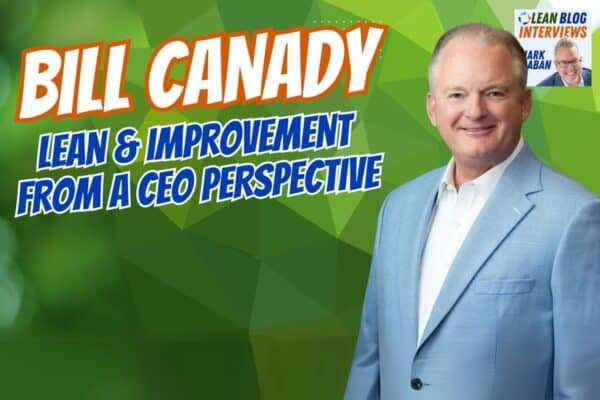Scroll down for how to subscribe, transcript, and more
My guest for Episode #526 of the Lean Blog Interviews Podcast is Bill Canady, a seasoned global business executive, U.S. Navy veteran, and current CEO of Arrowhead Engineered Products.
Bill has led over 30 operating companies and thousands of employees across the industrial and consumer products landscape. Formerly CEO of OTC Industrial Technologies, he helped drive impressive growth-boosting revenues by 43% and earnings by 78%.
Bill is also the author of The 80/20 CEO and the upcoming From Panic to Profit, and he's a vocal advocate for using Lean and the 80/20 principle as complementary tools for transformation.
I also want to tell you about an upcoming event you won't want to miss. On April 23rd at 1pm Eastern, Bill will be joining me again as the guest in our next Ask the CEO webinar, hosted by KaiNexus. This is an interactive session where you can ask your own questions about leadership, Lean, the 80/20 Principle, and Bill's Profitable Growth Operating System–PGOS.
Join Bill for a live Q&A webinar on April 23rd via KaiNexus!
We discuss Bill's personal Lean journey, which began with Six Sigma and evolved into a deep appreciation for the power of Lean and continuous improvement. He shares how daily management, Kaizen events, and a focus on flow became core to his leadership toolkit–not just on the shop floor but also across the “carpeted” functions like order-to-cash and sales. As CEO, Bill doesn't just support Lean; he expects it. He talks candidly about making continuous improvement a condition of employment, not through fear, but by creating a culture where people feel safe, engaged, and energized by problem-solving.
You'll hear Bill's insights on applying Lean as a strategic enabler for profitable growth–not just a cost-cutting tool. He explains how the 80/20 principle helps companies focus their improvement energy on what really matters and how Lean helps teams sustain those improvements. He also shares real-world lessons on leadership, cultural alignment, and navigating resistance to change–especially among those clinging to old firefighting habits.
Whether you're a Lean practitioner, an executive, or someone aspiring to lead, this conversation is packed with practical wisdom. Bill offers a compelling blueprint for how to lead with humility, clarity, and purpose–using Lean and the 80/20 mindset to build resilient, high-performing organizations.
Questions, Notes, and Highlights:
- Can you share your origin story with continuous improvement and Lean?
- What was the context in which you were first introduced to these methodologies?
- How did your role evolve from operations into broader P&L responsibility?
- How did your perspective on Lean shift when you became a CEO?
- What role does daily management play in sustaining operational excellence?
- How do you apply Lean principles outside the factory floor–especially in “carpet land”?
- As a CEO, how do you strike the balance between solving problems yourself and enabling others to be problem solvers?
- How do you respond when leaders or team members resist Lean thinking or default to old firefighting habits?
- What does it mean to make Lean a “condition of employment,” and how do you introduce that mindset?
- How do you ensure people understand Lean isn't about layoffs, but about redeployment and growth?
- How do you connect Lean initiatives with business growth, not just cost reduction?
- Do you have an example of how improving quality or delivery led directly to business growth or profitability?
- What inspired you to write your first book, The 80/20 CEO?
- Why are the first 100 days so critical for a new leader?
- How does the 80/20 principle help leaders prioritize improvement efforts?
- What's the relationship between 80/20 analysis and Lean execution in your approach?
- What can we do to help more CEOs understand and embrace Lean as a strategic business system?
- How can companies start building momentum with Lean–even if they're just getting started?
- What's the focus of your new book From Panic to Profit, and how does it expand on your first?
This podcast is part of the #LeanCommunicators network.


Full Video of the Episode:
Thanks for listening or watching!
This podcast is part of the Lean Communicators network — check it out!

Automated Transcript (Not Guaranteed to be Defect Free)
Hi. Welcome to the podcast. I'm your host, Mark Graban. Our guest today is Bill Canady. He is a global business executive with over 30 years of experience leading industrial and consumer product companies.
He is currently CEO of Arrowhead Engineered Products and is the chairman of OTC Industrial Technologies, a private equity-sponsored firm. So he oversees 30 operating companies, more than 2,000 employees, and a billion dollars in annual sales. Until recently, he was CEO of OTC Industrial Technologies, and under his leadership, OTC achieved remarkable growth–revenues up 43% and earnings up 78%.
Throughout Bill's career, he's navigated complex business environments. He's honed a passion for the art and science of growth. He's developed what he calls the PGOS–Profitable Growth Operating System. It's a proven framework that helps businesses drive productivity, profitability, and smarter decision-making.
Before I tell you a little bit more about Bill, welcome to the podcast. How are you today?
Bill Canady:
Yeah, it's great to be here, Mark. Thank you so much for having me. And you're quite the hype man, so I have to get you doing my bio all the time.
Mark Graban:
Thank you for sitting through that. Sometimes people don't like to hear their bio read in front of them. Not the best use of your time, but correct me if I'm wrong on anything that was in the details there.
Bill Canady:
No, no, you got it all perfect.
Mark Graban:
Alright. Bill and I have had a couple of great opportunities to chat over the past months. I learned about Bill and we got connected. He's the author, first, of a book called The 80/20 CEO: Take Command of Your Business in 100 Days. And then I had an opportunity to read an advance copy of his next book. It's going to be released April 29. That book is titled From Panic to Profit: Uncover Value, Boost Revenue and Grow Your Business with the 80/20 Principle.
Final detail: Bill is a U.S. Navy veteran. He holds a summa cum laude degree from Elmhurst University and an MBA from the University of Chicago Booth School of Business. Also coming up in April, Bill is going to be joining me as part of the Kinexus Continuous Improvement webinar series. He's going to be our second guest in an occasional series called “Ask the CEO.” So if there are questions I don't ask Bill today, you can submit questions and hopefully join us on April 23rd.
So Bill, it's a great opportunity to hear from your experiences as a CEO and P&L leader in different businesses. And I have a lot of questions to ask about that. But first, as I tend to ask everybody–at least in recent years on the podcast–how would you describe, as your career evolved, your origin story with continuous improvement or operational excellence or Lean–or however different companies might have framed that?
Bill Canady:
First of all, it's great to be here. I always enjoy our conversations. When I look back over my career, at first you're just happy to be in the game. As you progress, you realize you need to get really good at something–and many things are out of your control: the market, your customers, etc. But what you can control is your internal process, and continuous improvement gives you tools to do just that. It's something you can go out and do every day.
I always make the example–you can turn that light on or off, you can have that inventory there or not. It's one of the few things that is a proven way of making your business better and treating your customers the way they want to be treated–by having great continuous improvement.
Mark Graban:
And do you recall which company you were at, or some of the context for learning this? Was it a consultant who was brought in? Someone you were reporting to? Or maybe a team member said, “Hey, we should be doing this”?
Bill Canady:
Yeah, it was kind of done to me, I think is the best way to think about it. So I was early in my career, just out of the University of Chicago. My first big job was with a company called Invensys. And Invensys, at the time, was focused on Six Sigma. We had a big automotive business, among other things. It was really all about documentation.
So we came in, got our green belts, and did the things we had to do. But as my career progressed, the approach shifted–from Six Sigma to Lean. From variation control to waste reduction. I guess I'll always be a green belt–definitely not a practicing one anymore in Six Sigma–but with Lean, a lot of the success I've had today ties back to that training.
We brought in outside firms, like Next Level Partners–some great ones. That was one of the first I really remember getting a strong foundation from. It was a corporate-wide program, and I was in it. I was really happy to be part of it.
Mark Graban:
As your career progressed, I think a lot of people listening are in roles like engineering, process improvement, or operations management. I'd love to hear how your role shifted toward full P&L responsibility, and what advice you'd give to others who want to make that leap into broader business ownership.
Bill Canady:
It's really interesting. I started out as a commercial person–I was out selling. My first job was pushing a windshield down the road. I was driving around, seeing customers. And in that kind of role, you don't think about Lean at all. In fact, most people think Lean is something that happens on the factory floor.
We had this saying–I don't know if it's still true–but it was “carpet and concrete.” If you were in the office, you had carpet and didn't do anything with Lean. But out on the floor–on the concrete–you were deep into Lean.
So when I first moved from the sales side into operations, I got exposure to the factory floor. I was trying to get the machines working, remove bottlenecks–we used everything from SMED to flow analysis. That's when I got grounded in it.
But as I got promoted and moved into general manager roles, the real opportunity turned out to be in the carpeted areas. In the office.
We used to call it “carpet land.” And honestly, the office was the most chaotic part. So we started applying Lean to our front-end processes–order intake, engineering, order-to-cash. We did value stream mapping and found all kinds of issues. Orders being taken and then falling apart, bottlenecks before they ever hit the factory. On the floor, we could take five seconds out of a process, but in the office, we could remove two or three weeks. That's where the big changes started happening for us.
Mark Graban:
Yeah, yeah. That gives me a flashback to Dell in 1999. Operationally strong–not strictly Lean, but very good at demand shaping and aligning sales with supply. They didn't sell too much of what they didn't have and used incentives to move the right inventory.
Bill Canady:
Exactly. And while we weren't focused on Dell specifically at the time, we were doing a lot of similar things. The key realization was: you can apply the same Lean tools to office processes. Kaizens, daily management, value stream mapping–they work just as well in admin as they do in operations.
Everything is the same: how long a Kaizen lasts, how you report it out, how you set targets. And once you do that, people start speaking a common language. They become aligned. We start thinking backward from the customer–what do they need, and how do we deliver it with the least friction?
Mark Graban:
So once you embraced Lean in both factory and office functions, how did that mindset carry forward when you became a CEO?
Bill Canady:
That's a great question. As you move up in leadership, your view broadens. Early on, you might say, “Those people over there are doing X,” but eventually, you realize–we're all the same team. And if you don't care who gets credit, amazing things can happen.
There were a few key events that shaped me. First, getting back into operations after being on the commercial side. Then being put back over commercial again–now with a toolbox of Lean methods I hadn't had before.
But the real game-changer? Daily management. Getting everyone in front of the board–talking about safety, quality, delivery, cost. Not just the plant folks, but finance, HR, sales. Everyone. It creates a rhythm and a shared focus. And once I saw the power of that, I took it with me to every company I led.
When I take over a new company, the first thing I do is start daily management. Not because it's trendy, but because it works. It creates alignment. It helps everyone focus on the things that matter.
And let me be clear: I'm not an expert in all of these tools. But I understand their power. And as CEO, that's what matters–knowing what they do, insisting we use them, and making them part of our culture. It's not about me doing the Lean event–it's about supporting the people who do.
Mark Graban:
So what role does problem-solving play in your role as CEO, especially as someone who has grown up with these tools?
Bill Canady:
It's foundational. Problem-solving is the backbone. Whether it's 5 Whys, a fishbone diagram, or just walking the floor and observing, you have to respect the process.
And it starts with setting expectations: Lean is a condition of employment. That doesn't mean perfection–but it does mean participation. If you're not willing to be part of this, that's a problem. We don't beat people up, but we also don't compromise on our standards. Everyone has to try. Everyone has to engage.
Mark Graban:
How do you handle people who resist that? Folks who prefer firefighting or default to old ways–building inventory, being the hero when something goes wrong?
Bill Canady:
Great question. The key is relentless communication and clarity of vision. Early on, we lay out the strategy, the structure, and the expectations. And then we pay attention. Most people show us who they are in that first phase.
Some folks resist because they're afraid. Others because they're stuck in their habits. Either way, we coach them. But eventually, it becomes clear–some people don't want to be on this journey. And that's okay. It's not about being a bad person. It's about fit.
If you thrive in firefighting and chaos, that might work elsewhere. But not here. We're building a system, not a hero culture.
Mark Graban:
Yeah, and there are still plenty of companies doing things “the old way.” Some people may prefer working in environments that reward firefighting and tolerate inefficiencies. But for those who want to be part of a growing, learning organization, Lean provides a better path.
Bill Canady:
Exactly. I've heard it all–“We're different,” “You don't understand our business,” “Lean doesn't apply here.” My response? “Yeah, you're different. You're losing money, your on-time delivery is terrible, and your employees are frustrated. Let's fix that.”
Lean gives us a way to improve–systematically, sustainably. It's not magic. It's just structure, focus, and discipline.
Mark Graban:
Let's talk about how Lean connects to growth. You emphasize growth as a key goal–versus cutting cost. Why is that distinction important?
Bill Canady:
Because growth is inspiring. Growth creates opportunity. If people think Lean is just about eliminating jobs, they'll resist it. But if they see it as a way to grow and thrive–different story.
We don't grow by adding headcount and hoping it all works out. We grow by getting better, by eliminating waste, by freeing up resources so we can reinvest. We improve lead times, quality, and delivery–and that wins us more business.
Lean lets us redeploy people instead of laying them off. It lets us do more with the same team. That's good for business and good for morale.
Mark Graban:
Do you have a favorite example of where Lean led to improvement in quality or delivery and then to growth?
Bill Canady:
One that stands out: we had a business with long lead times and poor delivery performance. We started with a Kaizen–mapped the process, removed bottlenecks, fixed some scheduling issues, and standardized how we communicated.
The result? Orders got out the door faster. Quality complaints dropped. Sales had more confidence. Customers came back. And that improvement gave us capacity we didn't even know we had. No capital investment needed–just smarter processes.
Mark Graban:
I love that. And I want to transition a bit to your book, The 80/20 CEO. What inspired you to write it?
Bill Canady:
Two reasons. One, I always wanted to write a book. Two, I had built a repeatable system over time. Every time I took over a business, I found myself doing the same things, saying the same things. So I packaged that into a framework.
The book is really three parts: a little bit about me for context, the four steps to take command and control of your business, and then the toolbox–Lean, 80/20, daily management, strategic planning. Simple ideas, but powerful.
Mark Graban:
And your subtitle mentions the “first 100 days.” Why are those so important?
Bill Canady:
Because that's when the tone is set. People are watching. If you don't show progress in those first 100 days, you become part of the problem. But if you come in with a plan and start making smart moves, you build momentum.
It doesn't mean you solve everything in 100 days. But you start. You define the mission. You align the team. You install daily management. You create clarity. That sets you up for longer-term success.
Mark Graban:
Your new book, From Panic to Profit, is coming out soon. What's the focus of that one?
Bill Canady:
It goes deeper. It's a hands-on guide for taking a business that's stuck–or in trouble–and turning it around. It walks through how to use 80/20 analysis to segment customers and products, where to focus your efforts, how to simplify and execute.
It also talks more about leadership–how to communicate, how to drive change, how to build a team that gets it. And Lean is woven all through it. Because again, 80/20 tells you where to go; Lean helps you get there.
Mark Graban:
Beautifully said. And you've got a third book coming?
Bill Canady:
Yes. It's going to focus on talent–how to build the right team, how to structure for growth, how to align roles to strategy. We're calling it The Rule of Three. Still a work in progress, but I'm excited about it.
Mark Graban:
Bill, thank you for being so generous with your time and insight. For listeners, check out the books and the upcoming webinar. Links are in the show notes. Bill, thanks again.
Bill Canady:
Thank you, Mark. Always a pleasure.
What do you think? Please scroll down (or click) to post a comment. Or please share the post with your thoughts on LinkedIn – and follow me or connect with me there.
Did you like this post? Make sure you don't miss a post or podcast — Subscribe to get notified about posts via email daily or weekly.
Check out my latest book, The Mistakes That Make Us: Cultivating a Culture of Learning and Innovation:











The approach to applying Lean beyond the factory floor really resonates with me. It really shows how Lean can impact all aspects of an organization. In your experience, what are the most common challenges leaders face when trying to implement Lean principles in non-manufacturing areas?
I thought how Bill emphasized the CEO’s role in actively championing Lean principles to drive sustainable, profitable growth was very insightful. A question that came to mind while reading this transcript is how do you ensure that Lean Six Sigma initiatives stay aligned with overall business strategy especially as market conditions and customer needs evolve?